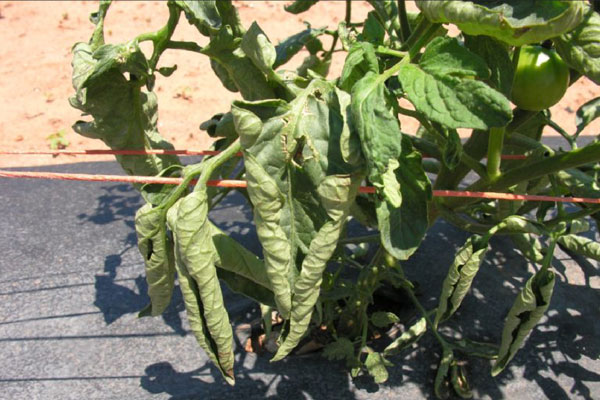Carefully tended tomato plants and a healthy, sunny environment produce glossy, firm green leaves. Plants with leaves that appear shriveled, wilted or dried out are likely suffering from a lack of adequate care or a bacterial, soil-borne disease. Determine if your tomato plant is actually drying out or if another condition is causing the plant stress.
Contents
Leaf Roll

Leaf roll, also called leaf curl, causes the lower leaves of a tomato plant to appear to dry out. The leaves curl inward at the edges due to rainy, cool, and damp weather conditions. The leaves become thick, leathery and rough. However, the roll of the leaves does not affect the health of the plant, and you do not need to treat the plant. When it rains, the weather cools down, the leaves shine and shine.
Fungicides and herbicides
Fungicides and herbicides can deform or permanently deform tomato plant leaves and fruit. Tomato plants are particularly sensitive to 2,4-D fungicide, a compound similar to plant hormones. Damage from excessive use of the spray bends leaves downward and causes cupping (which may look like drying or wilting). If exposure to the harmful spray is not too severe, tomato plants can tolerate the injury and produce healthy blossoms and flowers. To compensate for the damage, water the plant regularly-at least 1 inch of water per week-regularly.
Over- or under-watering.
Tomato plants need at least 1 inch of water per week. For tomato plants growing in hot, humid climates such as Texas or Arizona, watering the plant with 2 inches of water per week is ideal. Since tomatoes are 90 percent water, they need plenty of water to produce healthy, juicy fruit. Underwatering a plant will cause the leaves to dry out and the plant will eventually die, probably without ever setting fruit. Increase watering when underwatering is likely, and water the plant every day for a week to see if symptoms disappear. Water the plant directly at the roots until the soil settles at the root. Overwatered plants will show symptoms similar to thirsty plants, such as shriveled leaves. Reduce watering to at least 1 inch of water per week, especially if heavy rain falls frequently in your area.
Fusarium or Verticillium Wilt
Fusarium and Verticillium wilt are both soilborne bacterial diseases that first appear in the lower leaves of a tomato plant as shriveling and wilting. The leaves then turn yellow, usually resulting in premature death. The two diseases exist in garden soils where plants susceptible to the disease grow. Gardeners have developed disease-resistant varieties – labeled “V”, “F” or “VF” resistant. Planting these varieties is the only control. Otherwise, there has been no treatment for the diseases since 2011. Remove the entire plant and all plant parts from the garden bed or container and plant disease-resistant plants, preferably in a new, uninfected garden.









